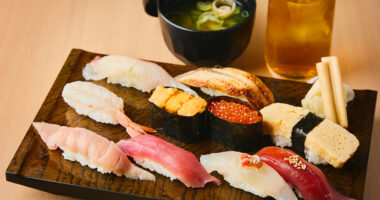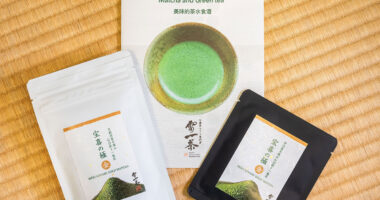In Japan, the act of gift-giving holds a significant place in social and cultural customs. お土産 omiyage, referring to souvenirs or gifts, often take the form of distinctive snacks. These snacks are not just tasteful delights but also embodiments of regional uniqueness, aesthetic allure, and profound cultural symbolism. As such, for tourists visiting Japan, these snacks serve as ideal gifts, effortlessly carrying a piece of Japanese tradition and craft back home. This guide offers a deeper understanding of the diverse world of traditional Japanese gift snacks, primarily focusing on those indigenous to Japan. Whether you’re planning a trip or just curious about Japanese food culture, this exploration will equip you with a broader palette of Japanese gifting options.
What are Japanese Traditional Gift Snacks?
Traditional gift snacks in Japan offer a delightful window into the country’s culinary heritage, from the distinct flavor profiles of local ingredients to the finesse of century-old techniques. Often packaged in elegant boxes, these snacks are not just treats but expressions of gratitude, celebration, and respect. Be it a crispy お煎餅 osenbei rice cracker or an intricately shaped 和菓子 wagashi (Japanese sweet), each snack is a testament to the Japanese commitment to perfection, even in the smallest of details.
Where to Get Japanese Traditional Gift Snacks
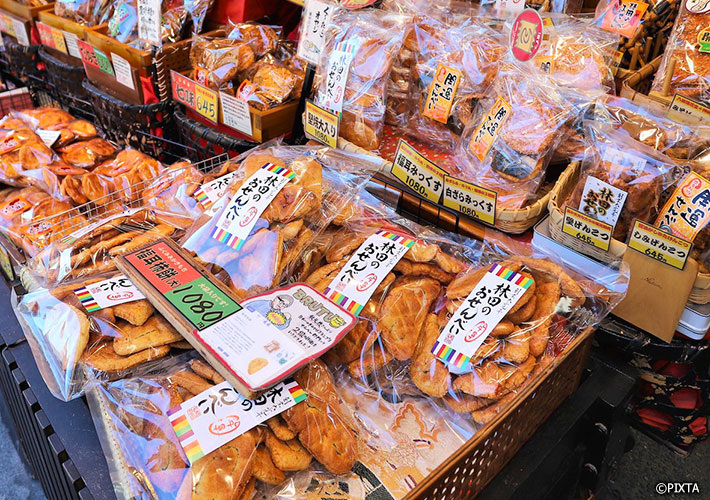
Traditional osenbei rice crackers on display at a specialty snack shop.
Japan’s traditional gift snacks can be found in a variety of places. Large department stores house extensive food halls where vendors sell beautifully packaged gift snacks. Traditional sweet shops, specialty snack stores, and even local supermarkets also offer a wide array of options. Many train stations have shops selling regional specialties, making them perfect spots to pick up a unique gift snack. If you missed an opportunity to buy a regional snack in person, you may even be able to buy some online and have them delivered to your hotel.
Types of Japanese Traditional Gift Snacks
The vast array of traditional Japanese snacks is too extensive to cover in a single article. Even seemingly simple treats like かりんとう karintō, a type of sweet, deep-fried dough, can range from everyday snacks to high-end gifts. In this guide, we’ll focus on a select few traditional snack types that are commonly gifted, embodying Japan’s unique food culture and tradition.

A tasty assortment of wagashi snacks.
和菓子 wagashi traditional Japanese sweets: Typically made from plant-based ingredients like mochi, 餡子 anko red bean paste, and fruits, wagashi come in an array of shapes and designs inspired by nature, often reflecting the season in which they are made. Some popular types include 団子 dango rice dumplings on skewers, どら焼き dorayaki, a pancake-like sweet filled with red bean paste, 大福 daifuku mochi with a sweet filling, 羊羹 yōkan, a firm, jellied dessert made of red bean paste, agar, and sugar, and 饅頭 manjū, cakes with sweet fillings. Regional varieties will sometimes use local ingredients like matcha and chestnut. Many of the popular gifts available in gift shops throughout Japan represent some form of wagashi. For a deeper dive into the world of wagashi, visit our full guide here.
Osenbei Crackers
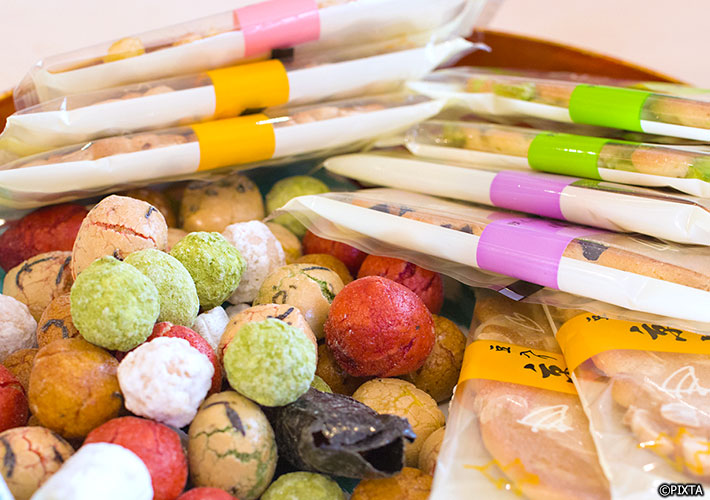
Assorted osenbei rice crackers.
Traditional crackers, known in Japanese as お煎餅 (or おせんべい) osenbei, are a staple in the realm of Japanese snacks. Although there are some minor genres which use potato starch or flour, the most common variety is made with rice, either 糯米 (or もち米) mochigome, a highly glutinous type of rice used to make mochi rice cakes, or 粳米 (or うるち米) uruchimai, a less glutinous type of rice which is typically eaten at all meals in traditional Japanese cuisine.
おかき okaki: Okaki, made from glutinous rice, are usually shaped into small cylinders or thin discs. These rice crackers, often seasoned with soy sauce, are then baked or fried, creating a light and crispy texture. Some varieties are also coated in nori (seaweed) or dusted with a sweet or spicy seasoning.

Colorful okaki made with glutinous rice.
あられ arare: Also made from glutinous rice, arare are similar to okaki but smaller in size – often as small as a pea. They come in an assortment of shapes, including tiny stars, balls, and squares. Arare can be either sweet or savory, with flavorings ranging from soy sauce, seaweed, and sesame to a sweet sugar glaze. Among arare, 柿の種 kakinotane, shaped like persimmon seeds, are a beloved snack and bar food staple.
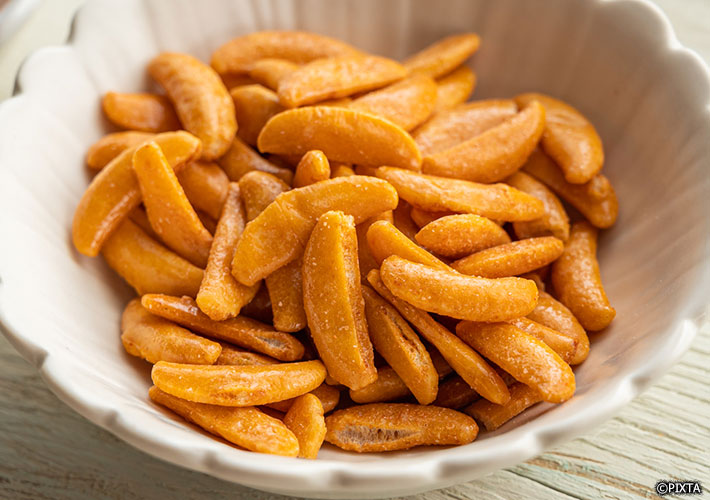
Kakinotane are commonly served to accompany drinks in bars and pubs.
焼きせんべい yaki-senbei: Yaki-senbei, made from non-glutinous rice, are typically larger and round. They are traditionally grilled over charcoal, a cooking method that lends the crackers a rich, toasty flavor. The most common yaki-senbei variety is soy sauce-flavored, although salt and seaweed versions are also popular.

Yakisenbei rice crackers made with non-glutinous rice.
揚げせんべい age-senbei: These deep-fried rice crackers are known for their crispy texture and often come seasoned with soy sauce. Some age-senbei are also covered in a thin layer of sugar glaze, providing a delightful balance of sweet and savory flavors.
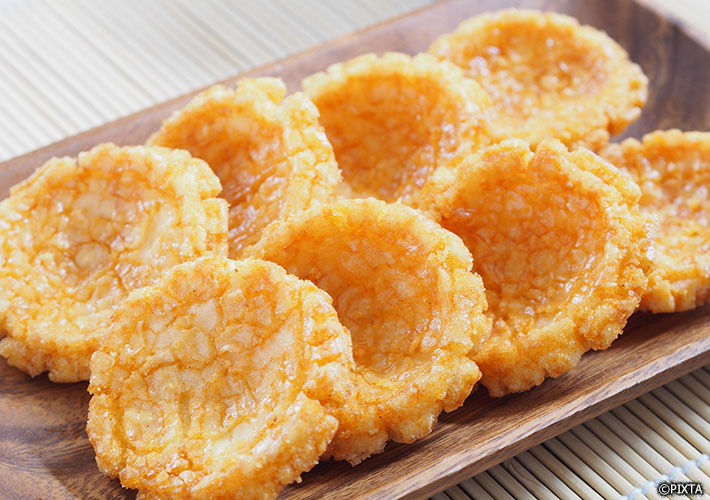
Agesenbei rice crackers have a crispy texture.
えび煎餅 ebi-senbei shrimp crackers: A luxurious type of cracker, ebi-senbei mainly uses potato starch—although rice is sometimes also included—and prominently features shrimp to deliver an ocean-inspired flavor profile. Some of them even have whole shrimp in them. Although inexpensive versions, usually light and puffy, are often available in convenience stores and supermarkets, ebi-senbei made by traditional cracker manufacturers are in a league of their own.
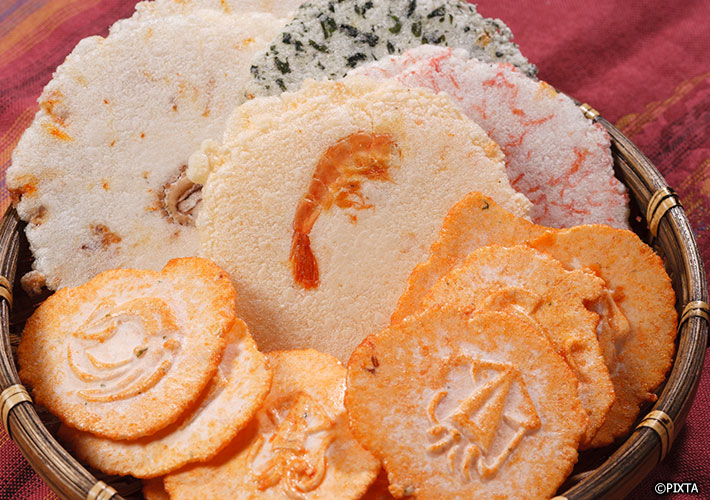
Shrimp lovers will surely appreciate ebi-senbei.
Dried Fruits and Vegetables: Beloved for their concentrated flavors and health benefits, dried fruits and vegetables can be enjoyed as is, incorporated into dishes, or given as gifts. There are two, however, which stand out as gift-worthy choices.
干し柿 hoshigaki, or dried persimmons, are a traditional Japanese treat. The persimmons are carefully peeled and then dried in the sun, a process that draws out the fruit’s natural sugars. This creates a crispy exterior and a soft, almost custard-like interior. Hoshigaki is prized for its complex sweetness and unique texture.
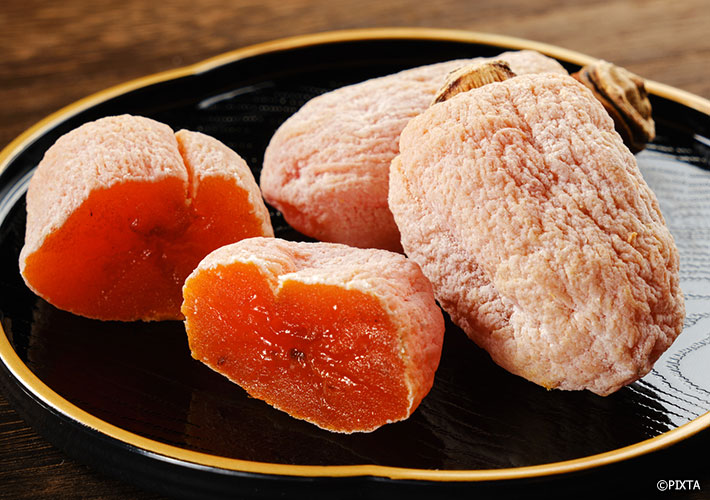
Dried persimmons are not only delicious but healthy too.
干し芋 hoshiimo, dried sweet potatoes, are another classic. They are typically made in autumn when sweet potatoes are at their peak. The drying process intensifies the sweet potato’s natural sweetness, resulting in a snack that is sweet, chewy, and deeply satisfying. Hoshiimo can be enjoyed as is or rehydrated and used in cooking.
Tradtional Japanese Candy: Japan’s traditional candies are a delightful representation of its rich cultural heritage. The most famous among them is surely 金太郎飴 kintarō-ame, a hard candy typically featuring the image of the iconic folk hero Kintaro. The candy is created using a method in which colorful rolls of candies are layered and stretched out until the design miniaturizes. Each slice of the candy rod reveals the same design, a testament to the artisan’s skill. In addition to the classic Kintaro design, contemporary variants feature a range of different characters.

No matter where you cut the candy rod, each piece always features Kintaro.
If you’re lucky, you may also be able to experience and even purchase examples of 飴細工 amezaiku, an artistic candy craft that involves sculpting hot, pliable candy into various shapes, usually animals or mythical creatures. It’s primarily a street performance art and sold from stalls, but you may also find specialty stores offering these intricate creations, which make for great gifts.

An artfully created goldfish made of candy.
Western Confections: Though their origins trace back to various countries overseas, a number of Western sweets have won over the hearts of the Japanese populace. The list of these international treats includes Portuguese-inspired castella, French-derived sable (also known as Breton cookies), and langue de chat cookies, as well as the German baumkuchen. In Japan, these confections are often gifted and are typically crafted with a distinctive Japanese twist. Traditional cakes, cookies, and chocolates are often innovatively adapted to incorporate indigenous dairy products or uniquely Japanese ingredients such as matcha green tea or yuzu citron.
Moreover, throughout the years, Japan has learned from a host of Western baking and confectionary traditions, developing their own unique cookie, cake, and chocolate brands in the process. These products have become a staple in local convenience stores and supermarkets, and are a part of everyday Japanese snacking culture. Some of them have garnered popularity among international tourists for their unique fusion of Western style and Japanese flavor profiles. These everyday snacks are budget-friendly, usually costing between 100 and 200 JPY per box.
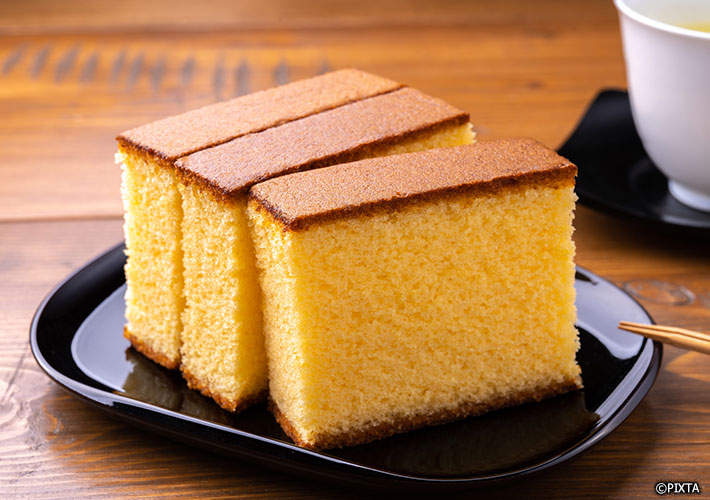
An example of Western confections in Japan is castella cake.
Speaking of pricing, when it comes to traditional Japanese snack gifts, the impact on your budget will vary broadly, refelecting the diversity of the offerings. For items such as rice crackers, gift packages range from just under a thousand to several thousand yen for larger packages or even more for luxurious ebi-senbei. Artisanal delights like wagashi or high-quality dried fruits can also command several thousand yen. Western-style confections, when purchased as gifts, typically start around 1,000 JPY and can go up to several thousand yen depending on the brand and the size of the box. The price of these snacks is influenced by factors like ingredients, craftsmanship, brand prestige, and packaging.
Tips For Enjoying Japanese Traditional Gift Snacks
When choosing a traditional gift snack, consider the recipient’s preferences, the occasion, and the season. Many snacks are seasonal, meaning their availability changes throughout the year. Some items have very short shelf lives so travelers should check the expiration date and make sure they are able to take the item with them on a plane back to their home country first. Another tip is to look out for regional specialties. Each region in Japan has its unique snacks that reflect its local culture and produce. For example, Sendai is known for ずんだ zunda (sweet edamame paste) sweets, Okinawa for ちんすこう chinsukō cookies, while Kyoto excels in refined wagashi.
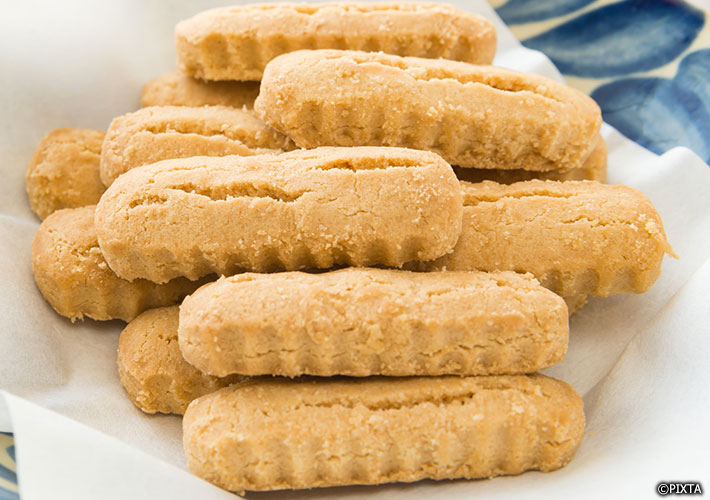
Chinsuko are a specialty from Okinawa.
In conclusion, the wide variety of traditional gift snacks in Japan reflects the country’s rich culinary heritage. Infused with unique flavors, textures, and craftsmanship, these snacks offer more than a simple gastronomic delight. They embody elements of Japan’s culture, tradition, and artistry. Engaging with these snacks isn’t just about experiencing diverse tastes, it’s an immersion into a flavorful tradition that continues to delight, surprise, and capture the essence of Japanese hospitality.


